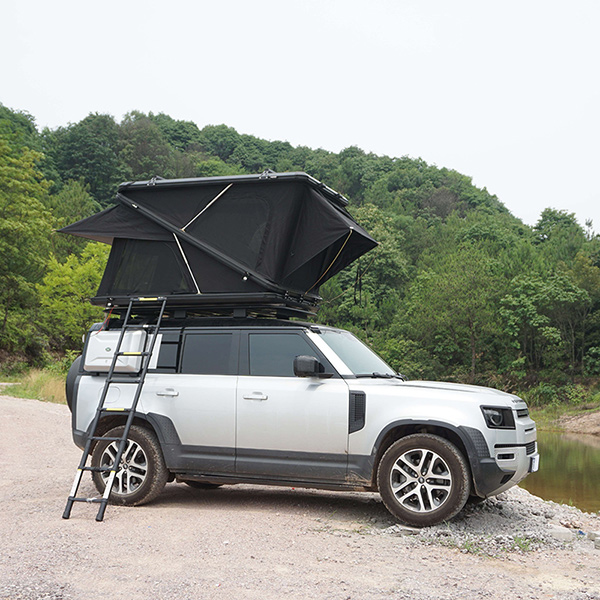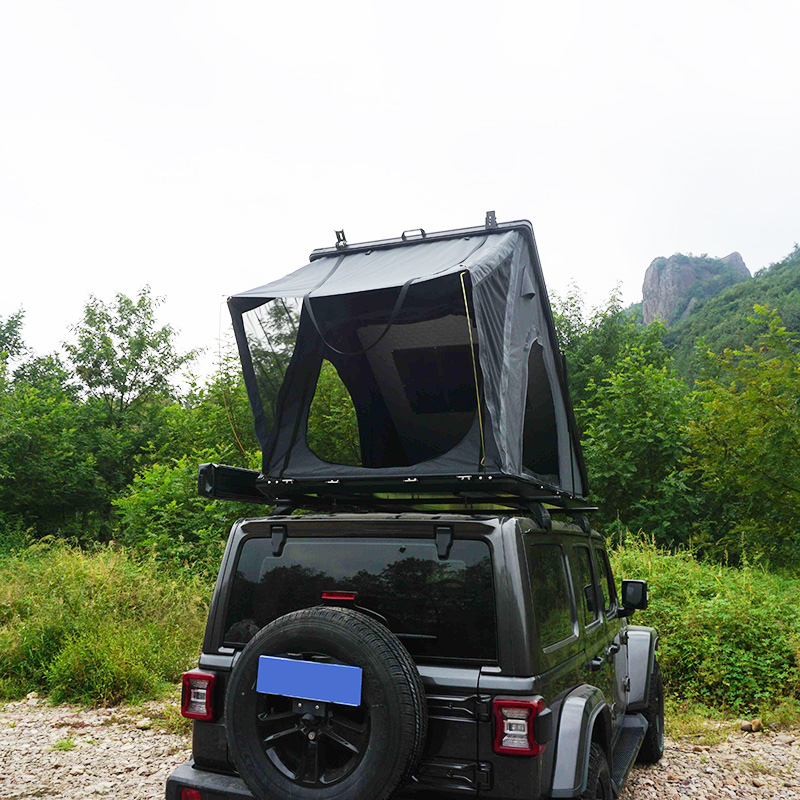Rooftop tents (RTTs) are the darlings of the overlanding world right now. It seems nothing gives you more social media cred than showing off a new rooftop tent on your latest epic, off-grid camping expedition (bonus points if it’s captured with drone footage).
It’s no surprise that Instagram and YouTube are full of rooftop tent videos. That’s all with good reason: They’re versatile, comfortable to sleep in, and look damn cool to boot. Plus, they provide most ordinary street vehicles with ultralight travel trailer-esque utility without the sky-high price tag of actually buying an RV. But, there are downsides, especially for softshell rooftop tents. Some are obvious, and some are not so obvious, especially for first-time buyers. Rooftop Camping Tent

If you’re shopping for rooftop tents right now, you no doubt know all the advantages. You don’t need us to convince you to buy one. Before you drop $3,000 on the best rooftop tent you can find, however, consider the downsides, too. We’re not trying to talk you out of buying one and buying a car tent instead, but it’s worth understanding what you’re getting into.
Before we get into the reasons to not purchase a rooftop tent, let’s clear up exactly what a rooftop tent is.
An RTT is a portable shelter that mounts to the roof of a vehicle. It’s a type of elevated camping tent that keeps you off the ground. They are typically made of durable materials that can withstand harsh weather conditions. Rooftop tents often come with built-in mattresses, which makes them more comfortable than ground tents. They are easy to set up and take down and don’t take up any space inside the vehicle. On the other hand, a car tent is a portable shelter that attaches to the back of the vehicle. It’s a non-elevated camping tent, which can be less convenient than a rooftop tent.
If you already own or are shopping for a rooftop tent, you’re aware of the most obvious drawback: the price. Rooftop tents are expensive. Some of the best camping tents on the market cost less than $400, while halfway-decent, entry-level rooftop tents start north of a thousand dollars. For upgraded models that are lightweight, made with better materials, and boast integrated features like LED lighting, solar panels, and heated back massagers, that price balloons quickly to several thousand dollars or more.
Plus, pickup owners will likely need to purchase a special rack to mount a new RTT in the bed of their truck. Some car and SUV owners may also need to buy a roof rack or additional hardware to mount a new RTT to their vehicles. That’s an additional cost on top of the tent itself. It all adds up fast.
This might be the best reason not to buy a rooftop tent, and the one most prospective buyers overlook. Camping or overlanding with an RTT means that your shelter and transportation are one and the same. Once you make camp and set up your tent, you can’t explore the surrounding area with your vehicle without breaking it all down first and resetting it up later.
That might not seem like a big deal, especially with many RTT owners on social media highlighting their (completely unrealistic) sub-60-second breakdowns. In reality, many of the best rooftop tents take ten to 20 minutes or more to break down completely and another ten to 20 minutes to set up again. Depending on your exploration style, this can easily waste an hour or two every day.
If you’re a light sleeper, know that sleeping in a softshell rooftop tent can be loud — like, very loud. It’s not surprising since they’re elevated off the ground by design and made of a complex web of overlapping fabric. Wind buffeting, especially in high-wind areas, can cause that fabric and rainfly to flap violently to the point of being downright deafening. For most of us who escape into the backcountry for peace and quiet, that fact alone can be a deal breaker.
Unless you’re a bat or a tree sloth, you probably enjoy sleeping in a reasonably level position. Leveling a ground tent is easy. Before pitching, just move it around in the dirt and lie down to check for level. But leveling a rooftop tent means leveling your entire vehicle, which often requires leveling blocks (or at least a decent-sized rock or two), a bubble level (if you want to save yourself some serious headaches), and potentially driving and reversing for a while every time you make camp. It’s not difficult, but trust us, it is tedious.
More specifically: They won’t come off. Technically, they’re not permanent. But most models weigh between 100 to 200 pounds. Add to that they’re clunky and cumbersome, which means you’ll almost certainly need a friend or two to help with the uninstall. Realistically, once you install yours, you’re unlikely ever to take it off, even when you don’t need it. It’s more convenient and back-saving to leave it on all the time. That leads to the next point.
No matter how lightweight or streamlined the RTT is, your gas mileage will take a hit after installing one. It’s simple physics. Your vehicle will be less aerodynamic, especially on the highway, and forced to move more weight than usual. From a gas mileage perspective, it’s like having an additional adult passenger in your car at all times. Losing a couple of miles per gallon might not seem like much but for gas-hungry trucks and SUVs, even a minor hit to fuel efficiency stings at the gas pump.
One apparent benefit of rooftop tents over traditional camping tents is being elevated off the ground and away from critters. Realistically, anything that crawls on the ground has no problem climbing the side of your vehicle and onto — or into — your tent. Depending on where you’re camping, that can include spiders, ants, mice, squirrels, wolverines, and most certainly, bears. It might feel more secure than a typical tent. In reality, it’s not.
With all of this said, we don’t hate rooftop tents. They’re awesome for the right style of camper with the right discretionary income. But if you’re considering buying one, don’t rely solely on overlanding influencers for your research. It’s just not as simple as they make it look.
Few things are more liberating than hitting the open road — whether that means a simple weekend road trip with friends and family or a year-long, cross-country expedition living the van life as a “digital nomad.” If you’re looking to do just that, you need a well-equipped basecamp. If traditional tent camping the whole way is “roughing it” too much, but you’re not looking to splash out on an uber-luxurious, quarter-million-dollar class A motorhome, a compact, lightweight travel trailer might be just what you need.
Buying any new (or new to you) RV is exciting, but it can be confusing, a little overwhelming, and even downright stressful. Every company offers a long list of standard and optional features, and it’s tough to know what you really need, especially if you’ve never done “the whole RV thing” before. That’s why we rounded up the best models from the most popular brands, including Airstream, Jayco, Winnebago, and Casita, to compare all the features, specs, and options that matter. This is our 2023 travel trailer showdown.
It's the perfect time of year for backyard barbecues and parties — it's still plenty warm for a night out under the stars, and even as the weeks grow slowly chillier, nighttime dips in the pool or lake will give way to making s'mores in the firepit, cup of hot chocolate or mulled wine in hand.
The world of lighting just got a major upgrade as Solo Stove, renowned for its innovative fire pits and outdoor accessories, expands its modern fire experience to a whole new category with the launch of the Solo Stove Mesa Torch. This addition to the tiki torch industry promises to illuminate your backyard with a huge flickering flame, adding a touch of excitement to your outdoor experience. All about the Solo Stove Mesa Torch A sleek and functional design The Solo Stove Mesa Torch is not your average backyard torch. It's crafted from cold-rolled steel and finished with a sleek black powder coating. The 3-piece shaft can be adjusted to two different heights, giving you the flexibility to customize your backyard lighting to suit any occasion. Effortless fueling One of the standout features of the Solo Stove Mesa Torch is its versatility when it comes to fuel. This torch can be fueled by any type of Torch Oil. That said, Solo Stove also will be offering its own brand of Torch Fuel. The integrated fuel canister is designed for an extra-large flame pattern, ensuring that your outdoor space is beautifully illuminated. Safe and convenient operation Safety and convenience are paramount when it comes to outdoor lighting, and Solo Stove has taken this into account with the Torch. The detachable snuffer, complete with an integrated holder, allows you to easily extinguish the flame when the party's over or when it's time to call it a night. No need to worry about smoldering wicks. Impressive burn time Imagine enjoying the warm glow of your Solo Stove Mesa Torch for hours on end. With an approximate 5-hour burn time, it should last the length of your party. No need to constantly fuss with refueling or worry about the flame flickering out unexpectedly. Durability As with all Solo Stove products, the Torch is built to last. Its cold-rolled steel construction, black powder coating, and heavy-duty stake ensure that it can withstand the rigors of outdoor use. Solo Stove stands behind the quality of their products, and the Torch is no exception. It comes with a lifetime manufacturer's warranty.
Unless you’re glamping (i.e. luxury camping) or car camping with air conditioning and an air mattress, tent sleeping in the woods is rarely as comfortable as drifting off in the comfort of your own bed at home. But, with proper planning, it can be pretty darned close. It just requires preparation, the right outdoor sleeping gear, and a dash of compromise. Here are our top tips to more comfortably sleep in tents.
Start with the right tent Sleeping comfortably in a tent while camping starts with picking the right tent to begin with. You want one that's easy to pitch (so you're not struggling to get it up after dark right before bedtime), well-made (to protect you from bugs and rain), and roomy enough for you, your tentmates, if any, and a bit of gear too. This last bit is especially important. Most tents billed as "one person" or "two person" are exactly big enough for one or two campers, respectively, sleeping side by side on compact sleeping pads. There is often very little extra room for gear. That's why I personally recommend sizing up. If you like to camp solo, consider buying a two-person tent just for a little extra breathing room and to stash your gear in the event of inclimate weather.

Best Car Camping Tent The Essential Guide for MenThe Manual is simple — we show men how to live a life that is more engaged. As our name implies, we offer a suite of expert guides on a wide range of topics, including fashion, food, drink, travel, and grooming. We don’t boss you around; we’re simply here to bring authenticity and understanding to all that enriches our lives as men on a daily basis.